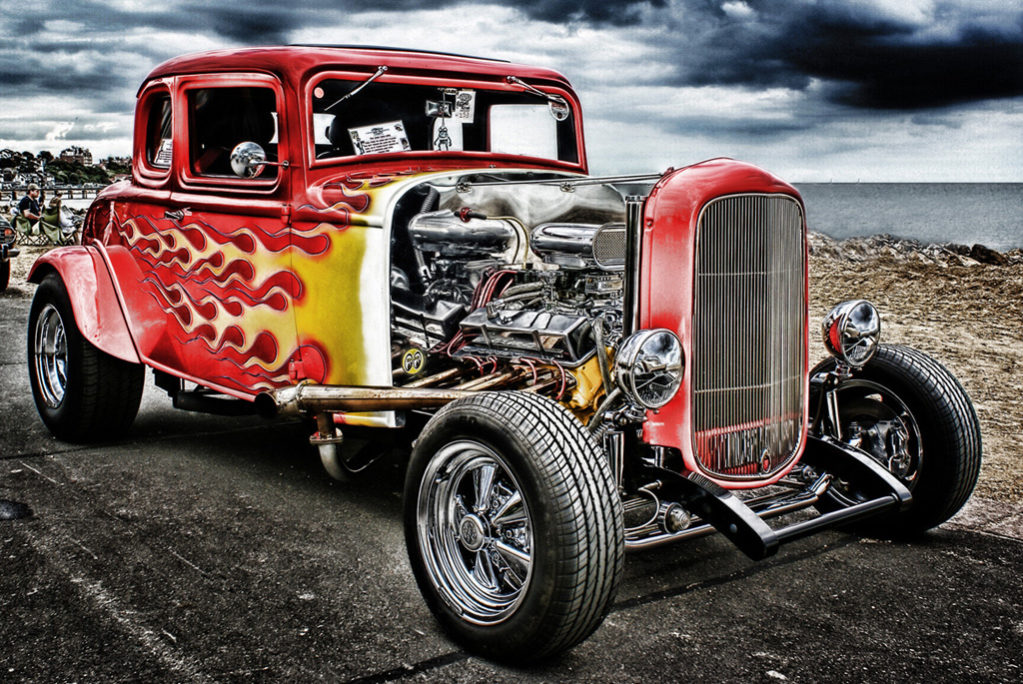Hot Rod

Hot rods are typically American cars with large engines modified for linear speed. The origin of the term “hot rod” is unclear. One explanation is that the term is a contraction of “hot roadster,” meaning a roadster that was modified for speed. Another possible origin includes modifications to or replacement of the camshaft(s), sometimes known as a “stick” or “rod”. A camshaft designed to produce more power is sometimes called a “hot stick” or a “hot rod”. Roadsters were the cars of choice because they were light. The term became commonplace in the 1930s or 1940s as the name of a car that had been “hopped up” by modifying the engine in various ways to achieve higher performance.
The term can also apply to other items that are “souped up” for a particular purpose, such as “hot-rodded amplifier”.
Late 1930s–1950s
The term seems first to have appeared in the late 1930s in southern California, where people would race their modified cars on the vast, empty dry lake beds northeast of Los Angeles under the rules of the Southern California Timing Association (SCTA). The activity increased in popularity after World War II, particularly in California because many returning soldiers had been given technical training in the service. Many were prepared by Bootleggers in response to Prohibition to enable them to avoid revenue agents (“Revenooers”); some police vehicles were also modified in response.[citation needed]
The first hot rods were old cars (most often Fords, typically Model Ts, 1928–31 Model As, or 1932-34 Model Bs), modified to reduce weight. Typical modifications were removal of convertible tops, hoods, bumpers, windshields, and/or fenders; channeling the body; and modifying the engine by tuning and/or replacing with a more powerful type. Speedster was a common name for the modified car. Wheels and tires were changed for improved traction and handling. “Hot rod” was sometimes a term used in the 1950s as a derogatory term for any car that did not fit into the mainstream. Hot rodders’ modifications were considered to improve the appearance as well, leading to show cars in the 1960s replicating these same modifications along with a distinctive paint job.
Engine swaps often involved fitting the Ford flathead engine, or “flatty”, in a different chassis; the “60 horse” in a Jeep was a popular choice in the ’40s. After the appearance of the 255 cu in (4.2 l) V8, because of interchangeability, installing the longer-stroke Mercury crank in the 239 was a popular upgrade among hot rodders, much as the 400 cu in (6.6 l) crank in small-blocks would become. In fact, in the 1950s, the flathead block was often fitted with crankshafts of up to 4.125 in (104.8 mm) stroke, sometimes more.[2] In addition, rodders in the 1950s routinely bored them out by 0.1875 in (4.76 mm) (to 3.375 in (85.7 mm));[2] due to the tendency of blocks to crack as a result of overheating, a perennial problem, this is no longer recommended.[3] In the ’50s and ’60s, the flatty was supplanted by the early hemi. By the 1970s, the small-block Chevy was the most common option, and since the ’80s, the 350 cu in (5.7 l) Chevy has been almost ubiquitous.[4]
Post WWII origins of organized rodding
Ford Popular
Rodded prewar British Rover 10
After World War II there were many small military airports throughout the country that were either abandoned or very rarely used that allowed hot rodders across the country to race on marked courses. Originally drag racing had tracks as long as one mile (1.6 km) or more, and included up to four lanes of racing at the same time. As hot rodding became more popular in the 1950s, magazines and associations catering to hot rodders were started. As some hot rodders also raced on the street, a need arose for an organization to promote safety. Hot rodders including Wally Parks created the National Hot Rod Association (NHRA) to bring racing off the streets and onto the tracks. They created rules based on safety and entertainment, and allowed Hot Rodders of any caliber the ability to race. The annual California Hot Rod Reunion and National Hot Rod Reunion are held to honor pioneers in the sport. The Wally Parks NHRA Motorsports Museum houses the roots of hot rodding.
1960s rise of the street rod
As automobiles offered from the major automakers began increasing performance, the lure of Hot Rods began to wane. It was no longer necessary to put a Cadillac engine in a Ford roadster to be fast. It was now possible to buy a muscle car that outperformed just about any hot rod, with more passenger room, and without having to expend the effort of building and tuning the car oneself. After the 1973 Oil Crisis, the public called on automakers to offer safety and fuel efficiency over performance. The resulting decrease in an average car’s performance led to a resurgence of Hot Rodding, although the focus was on driving Hot Rods over racing so the term ‘Street Rod’ was coined to denote a vehicle manufactured prior to 1949, often with a more reliable late model drivetrain. Street Rodding as it was now known was a different phenomenon than Hot Rodding, as Street Rodding was mainly family oriented. National events were hosted by the National Street Rod Association (NSRA), which also stressed safety as the NHRA did 20 years before, but this was safety for the street as opposed to on the race track. Each NSRA event has a ‘Safety Inspection Team’ that performs a 23 points inspection process that goes beyond what normal State Safety Inspections Require.
In the mid-1980s, as stock engine sizes fell, rodders discovered the all-aluminum 215 (Buick or Olds) could be stretched to as much as 305 cu in (5 l), using the Buick 300 crank, new cylinder sleeves, and an assortment of non-GM parts, including VW & Mopar lifters and Carter carb.[5] It could also be fitted with high-compression cylinder heads from the Morgan +8. Using the 5 liter Rover block and crank, a maximum displacement of 317.8 cu in (5,208 cc) is theoretically possible.[6]
